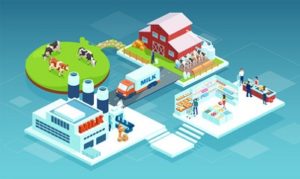
Unless, we were directly involved in one of these industries, we probably did not think about the complex system and numerous individuals it takes to put food on our tables. But when the food chain is disrupted by a global pandemic and the system starts to unravel beyond our control, reality sets in and we wonder what if this is our new “normal.”
Beyond the Pictures – The Reality

- Do you rely on restaurants or carry out for most meals, viewing your kitchen as “optional use”?
- Or have you ever grown zucchini in your backyard or raised chickens? What happens when the “supply exceed demands”? Your friends receive the excess, you adjust your menu to include more of the product, or when those options are no longer viable, you compost or leave them on the ground.
Multiply these personal scenarios by the number of people in the United States and suddenly we’re in uncharted territory. We, as a nation, haven’t stopped eating but our sources have changed dramatically in a matter of days. The food value chain is on overdrive to mediate food insecurity and food waste.
Here are the facts:
- We are in the height of the growing season for leafy greens in California and tomatoes and zucchini in Florida. Milk production is at its highest volume in the spring and the cows have to be regularly milked for their optimal health. Cows, like chickens, are not adjusting their production for COVID-19!
- At least 50% of the milk, produce, seafood, meat and egg supply is designated for the foodservice and restaurant industries with all the related processors and distribution systems along the way. When these venues shut down without warning, the food system has to recalibrate and chart a new course, but food waste will occur initially.
- Processors are working around the clock to increase production of perishable products like milk, and distribution channels are being modified as quickly as possible.
- Food distribution warehouses and specialty processors (like those for pizza restaurants) are full of food without a “home” so guidelines have to be changed to create a channel to move it out. For example, butter or sour cream packaged for foodservice operations cannot be sold to retail as packaging and labeling requirements are not the same. It also cannot be distributed to food banks due to its bulk package size.
- Farmers and processors, like the restaurant and retail industries, are facing the economic realities of this pandemic. Economic assistance through the stimulus package and regulatory adjustments are two actions agricultural-related entities are seeking as the dual reality of COVID-19 and plunging commodity prices continues to pose challenges.
- Farmers and ranchers need to have access to fuel, seed and fertilizer for crops. They also need feed, animal care and processing plants to keep their operations running and keep food on the shelves.
Focus on the Priority
Despite today’s realities, keeping our food supply flowing from the farmer to the consumer is top priority. But we may have to rethink priorities and focus on what is most important: food availability and accessibility.

From a local and regional perspective, family-owned produce farms and meat companies are creating more options for consumers to buy direct in lieu of farmers’ markets. Restaurants are adding butcher shops and basic grocery items to their “dining out options” for customer convenience and their own financial stability. And retail grocers are working tirelessly to adjust for the influx of consumers shopping online and in the store, all while modifying policies and practices to ensure safety for all.
Call to Action
Food is at the core of existence, and for some, availability and accessibility have never been a concern. These were basic needs that were always met, but not always appreciated. We may have understood the “farm to plate” connection but we failed to remember the numerous hands along the journey that keep food on our table. Anxiety may get the best of us during this time when our personal safety, health and basic needs are in jeopardy.

Resources:
1. “Dairy groups plead for relief amid COVID-19 impacts,” Food Business News, April 7, 2020.
2. “How to Document Dumped Milk,” AgWeb made by Farm Journal, Robin Schmahl, April 7, 2020.
3. International Dairy Foods Association
4. “Farm Bureau makes sweeping appeal to USDA to rescue producers nationwide,” Philip Brasher, Agri-Pulse, April 4, 2020.
5. “Saluting Unsung Heroes of the COVID-19 Crisis: The Food Supply Chain,” AgWeb made by Farm Journal, Tyne Morgan, April 6, 2020.
6. “The Impact of COVID-19 on Food & Ag Landscapes,” FLM/Harvest, Naomi Mortensen.
